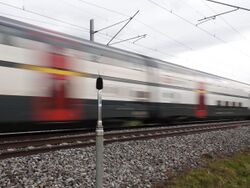Physics:Train noise
Train noise is vehicle noise made by trains. Noises may be heard inside the train and outside.
Subway systems, light rail transit and freight trains can send loud train noise into neighborhoods. Organizations such as the World Health Organization[1] and the U.S. Environmental Protection Agency have set guidelines for noise level decibel limits for rapid transit. Noise levels can be reduced by installing noise barriers next to the track.[2] Traditional clickety-clack sounds occur as a result of gaps in the rail to allow for thermal expansion. On most railways, the gaps are opposite each other and if the carriages are about the same length as the rails, an even clickety clack sound is generated. In the USA the rail joints are staggered, so not being opposite each other, a different and irregular sound is heard.
Sources
Several distinct sounds are created by various parts of the train, such as engines, traction motors, brakes, and the wheels rolling on the rails.
- Roughness and irregularities on the wheel and rail surfaces are a source of noise and vibration. Rail joints and squats on the rail cause a familiar "clickety-clack" sound as train wheels roll over them. Rail corrugation (a periodic wear pattern resembling corrugated metal) causes tonal noise and vibration; fine, short-wavelength corrugation is known as "roaring rails" due to its high-pitched sound, whereas coarse, long-wavelength corrugation can cause the ground and nearby buildings to vibrate.[3] Rail roughness and corrugation are treated by grinding the rails. This reduces noise in problem areas although trains make a distinctive tonal sound on freshly-ground track due to the pattern on the rail left by the grinding process, which wears flat over time.
- Rail squeal is a sound caused by a train's wheels slipping under specific conditions, usually around sharp curves.[4]
- Air displacement of a train in a tunnel can create noise from turbulence.
- Trains also use horns, whistles, bells, and other noise-making devices for both communications and warnings.
- The engines in diesel locomotives and DMUs produce significant amounts of noise. Newer locomotives have become much quieter in recent years due to noise regulations being implemented by countries and regions. However, there are still times that a locomotive may develop a defect in its turbocharger, which produces a whine that can be heard for many kilometers. While this is rare, and usually the said locomotive gets put into the shop quickly, the noise has been compared to an air raid siren, or a very large leaf blower. It appears to be the most common on units built by EMD (Caterpillar's locomotive division) equipped with the 710 series prime mover, although any turbocharged locomotive may develop this problem.
- Electric traction motors often produce electromagnetically induced noise. This high-pitch noise depends on the speed and torque level of the machine, as well as the motor type.[5] Variable-frequency drives use pulse-width modulation, which introduces additional current harmonics and results in higher acoustic noise. The switching frequency of the PWM can be asynchronous (independent of speed) or synchronous (proportional to speed), but always results in acoustic noise varying with speed.[6]
See also
- Noise health effects
- Active noise control
- Roadway noise
- Environmental noise
References
- ↑ World Health Organization. Regional Office for Europe. (2018). Environmental noise guidelines for the European Region. https://apps.who.int/iris/handle/10665/279952
- ↑ International Union of Railways (UIC), Sustainability, Railway Noise in Europe, State-of-the-art report, 2021, ISBN 978-2-7461-2990-0
- ↑ Grassie, Stuart L (Nov 2009). "Rail corrugation: characteristics, causes, and treatments". Proceedings of the Institution of Mechanical Engineers, Part F: Journal of Rail and Rapid Transit 223 (6): 581–596. doi:10.1243/09544097JRRT264. http://journals.sagepub.com/doi/10.1243/09544097JRRT264.
- ↑ Thompson, D.J.; Squicciarini, G.; Ding, B.; Baeza, L. (2018). "A State-of-the-Art Review of Curve Squeal Noise: Phenomena, Mechanisms, Modelling and Mitigation". Notes on Numerical Fluid Mechanics and Multidisciplinary Design 139: 3–41. doi:10.1007/978-3-319-73411-8_1. ISBN 978-3-319-73410-1.
- ↑ "J. Le Besnerais et al., Characterization of the audible magnetic noise emitted by traction motors in railway rolling stock", Noise Control Engineering Journal, ISSN 0736-2501, Vol. 57, Nº. 5, 2009, págs. 391-399
- ↑ J. Le Besnerais, V. Lanfranchi, M. Hecquet and P. Brochet, "Characterization and Reduction of Audible Magnetic Noise Due to PWM Supply in Induction Machines," in IEEE Transactions on Industrial Electronics, vol. 57, no. 4, pp. 1288-1295, April 2010. doi: 10.1109/TIE.2009.2029529
Bibliography
- Thompson, D.J. (2008). Railway Noise and Vibration. Elsevier Science. ISBN 9780080451473.
 |


